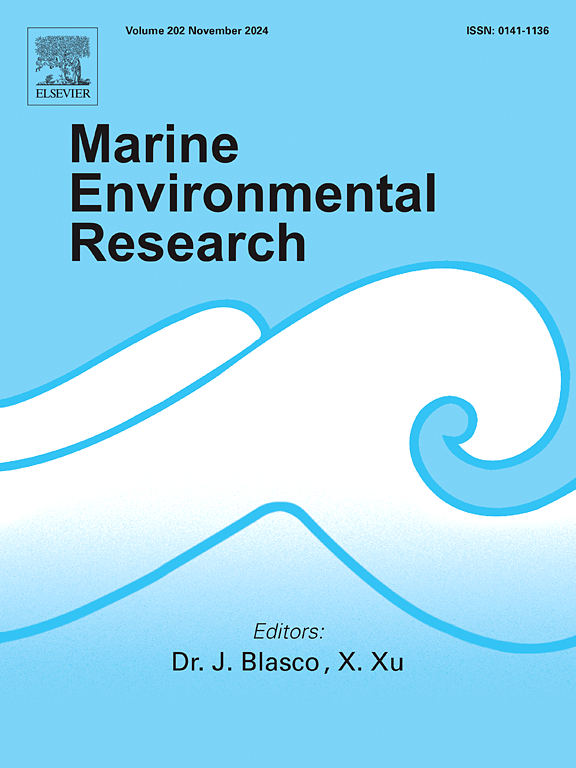微塑料在脱盐菌海草草甸中的滞留
IF 3
3区 环境科学与生态学
Q2 ENVIRONMENTAL SCIENCES
引用次数: 0
摘要
海草和沉积物对微塑料的捕获和储存突出了它们作为塑料颗粒潜在长期储存库的作用。本研究评估了加利福尼亚湾西南部Pichilingue和Los Aripes两个地区嗜盐菌草甸及其相关沉积物中MPs的存在。在每个地点,沿着两个30米的样带收集了12个样本:6个来自植被,6个来自无植被的地点。在Pichilingue发现93个项目,在根上最多发现46个项目,以膜和纤维为主要MP形式,黑色是最常见的颜色。对于沉积物,估计平均为231±145项kg−1 DW;植被区为406±184项kg - 1 DW,其中以黑色膜(1016项)最为丰富;非植被区为56±11项kg - 1 DW,以透明碎片(25项)为主。主要MP类型为聚乙烯(38项)。在洛斯阿里佩斯,没有在任何构形人身上发现MPs;在沉积物中,平均为17±7项kg - 1 DW,其中植被样地和黑色、蓝色纤维以13±3项kg - 1 DW为主(各7项),无植被样地和蓝色纤维以21±10项kg - 1 DW为主(16项)。聚对苯二甲酸乙二醇酯是MP的主要类型。该研究深入了解了沉积物和脱皮草结构(叶、叶柄、根茎和根)对来自当地人类活动和环境因素影响的MPs的保留能力。本文章由计算机程序翻译,如有差异,请以英文原文为准。
Retention of microplastics in Halophila decipiens seagrass meadows
Microplastic (MP) trapping and storage by seagrasses and sediments highlight their role as potential long-term reservoirs for plastic particles. This study evaluated the presence of MPs in Halophila decipiens meadows and its associated sediments in two localities, Pichilingue and Los Aripes, in the southwest Gulf of California. At each locality, 12 samples were collected along two 30-m transects: six from vegetated and six from unvegetated sites. At Pichilingue, 93 items were found on H. decipiens, with a maximum of 46 items on roots, with films and fibers being the main MP forms and black the most frequent color. For sediments, an average of 231 ± 145 items kg−1 DW was estimated; the vegetated site showed 406 ± 184 items kg−1 DW, with black films (1016 items) as the most abundant items, while the unvegetated site showed 56 ± 11 items kg−1 DW, with transparent fragments (25 items) as the dominant items. The main MP type was polyethylene (38 items). At Los Aripes, MPs were not found on any structure of H. decipiens; but in sediments, the average was 17 ± 7 items kg−1 DW, with 13 ± 3 items kg−1 DW in the vegetated site and black and blue fibers (seven items each) as the dominant items, and 21 ± 10 items kg−1 DW in the unvegetated site and blue fibers (16 items) as the dominant items. The main MP type was polyethylene terephthalate. This research provides insight into the capacity of sediments and H. decipiens structures (leaves, petioles, rhizomes, and roots) to retain MPs derived from local human activities and the effect of environmental factors.
求助全文
通过发布文献求助,成功后即可免费获取论文全文。
去求助
来源期刊

Marine environmental research
环境科学-毒理学
CiteScore
5.90
自引率
3.00%
发文量
217
审稿时长
46 days
期刊介绍:
Marine Environmental Research publishes original research papers on chemical, physical, and biological interactions in the oceans and coastal waters. The journal serves as a forum for new information on biology, chemistry, and toxicology and syntheses that advance understanding of marine environmental processes.
Submission of multidisciplinary studies is encouraged. Studies that utilize experimental approaches to clarify the roles of anthropogenic and natural causes of changes in marine ecosystems are especially welcome, as are those studies that represent new developments of a theoretical or conceptual aspect of marine science. All papers published in this journal are reviewed by qualified peers prior to acceptance and publication. Examples of topics considered to be appropriate for the journal include, but are not limited to, the following:
– The extent, persistence, and consequences of change and the recovery from such change in natural marine systems
– The biochemical, physiological, and ecological consequences of contaminants to marine organisms and ecosystems
– The biogeochemistry of naturally occurring and anthropogenic substances
– Models that describe and predict the above processes
– Monitoring studies, to the extent that their results provide new information on functional processes
– Methodological papers describing improved quantitative techniques for the marine sciences.
 求助内容:
求助内容: 应助结果提醒方式:
应助结果提醒方式:


